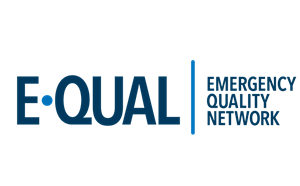
The Social EM Dilemma: The tension between a central EM mission and limited ED resources
Emergency medicine (EM) is uniquely positioned at the intersection of acute care and public health. The federal requirements of the Emergency Medical Treatment and Active Labor Act (EMTALA) have shaped EM as the de facto safety net for many vulnerable populations with diminishing primary care access in a primarily fee-for-service U.S. healthcare model. Consequently, EM has both the privilege and challenge of providing disproportionate care to many of the most marginalized, under-resourced, and socially vulnerable populations, inclusive of non–English speaking, ethnic minority, sexual and gender minority, under- and uninsured, unhoused, and undocumented populations.1-4 Recent studies suggest social vulnerability may drive emergency department (ED) visits, as well as poor health outcomes.5-12 Consequently, many EDs offer a lucid window into their communities’ social determinants of health (SDoH)—including patients’ multidimensional social vulnerabilities, upstream and downstream social and medical needs, and overall healthcare utilization—and offer an effective site to initiate meaningful interventions.
Centers for Medicare & Medicaid Services (CMS) has increased its emphasis on health equity and justice, as evidenced by its updated 2023 Framework for Health Equity.13,14 Yale’s Center for Outcomes Research and Evaluation (CORE) and CMS have subsequently developed a supporting Addressing Social Needs (ASN) Electronic Clinical Quality Measure (eCQM). This was designed to evaluate screening across four domains of social need in the inpatient setting—food, housing, utility, and transportation insecurity—in addition to assessing whether an intervention occurs for patients identified with aforementioned insecurities. While the measure was developed for the Hospital Inpatient Quality Reporting (IQR) Program, CMS anticipates its expansion to other domains.15 Given this purported trajectory, EDs should consider evaluating their preparedness for future mandatory SDoH screening for some, if not all, ED patients.
While an ever-increasing number of EM providers’ professional identities reflect the social EM paradigm,16-20 to date none of the U.S. EM representative organizations (ACEP, SAEM, AAEM) have arrived at a consensus that routine EM care should include formal screening for SDoH.5-21 A likely explanation for this divergence between EM mission and strategy is that most EDs currently face socio-structural challenges to implementing formal social vulnerability screening. This split is amplified when considering the necessary downstream interventions required for patients identified as having social needs. One social-ecological study demonstrated relevant and specific mezzo- and micro-level obstacles to performing such screening in the ED, including lack of healthcare system coordination, hierarchy within the medical model, pressure to discharge patients quickly, fleeting patient-provider interactions, high volume of patients, and empathic strain.22
As a recent excellent scoping review corroborates, there are limited published examples of the successful integration of SDoH screening into EM care, despite significant potential for impact.23 One large academic center ED in Utah developed a 10-question social needs screening tool and performed an initial 25-day feasibility trial24 In this pilot feasibility study, registration staff administered a low-literacy, English-Spanish screener that generated automatic referrals to community service outreach specialists and data linkages in patients screening positive for social needs. Screening was completed in 61% of the nearly 5,000 patients approached; approximately half of the patients indicated social needs.25 About one third of these patients agreed to follow-up by resource specialists, and many were referred to community agencies. At another large hospital in Washington, D.C., a survey was administered to adult Medicaid beneficiaries regarding social needs related to medical, behavioral health, wellness, housing, food, legal, and job training issues. Over 500 patients were enrolled, with 85% of them screening positive for at least one health-related social need. Almost half of those requesting assistance were provided referrals to three different agencies based on their top three 26 In an urban safety-net hospital in Colorado, a 10-question validated Accountable Health Communities Health-Related Social Needs Screening Tool was administered by patient navigators to evaluate Medicare and Medicaid patients. Over 1,200 patients were screened; of those, 44% qualified for patient navigator services. The patients who screened positive for social needs received a handout listing community resources, and among this group, those with two or more self-reported ED visits in the prior 12 months received ongoing post-discharge navigation using community resource referrals.27 Finally, one New York–based hospital system screened ED patients for food, transportation, and housing instability. The system leveraged an existing Emergency Department Patient Navigator program across 7 EDs, utilizing community health workers to screen patients. Over 8,000 patients were screened, 17.3% of them demonstrating a social need and over 50% accepting support. Patients with rising or high risk were referred to community-based organizations with which the health system had developed relationships.28
With the potential for a CMS EM SDoH performance measure, the current infrastructural constraints of many EDs and health systems should raise concerns, with historical reference of prior unfunded ED screening mandates for context. The 2006 CDC universal HIV screening recommendation, subsequently adopted by the New York State Department of Health as a mandate, has had notable successes but significant obstacles. Poor linkage to care, low test acceptance among marginalized populations, ineffective screening infrastructure models, redundant testing of patients with prior HIV diagnoses, and limited cultural competency of testing initiatives have been a few roadblocks for HIV screening programs in the ED.29 These described challenges to efficient screening processes have created an additional cognitive burden on frontline clinicians.30 In 2023, many EDs do not have the resources to complete (likely manual) SDoH screening, nor the sufficiently robust intra- and extra-institutional infrastructure to initiate referrals for downstream interventions in high-risk patients. Given the multidimensional challenges of contemporary EM—including staffing shortages,31 significant burnout, longer boarding times,32 and workplace violence33—such a performance measure could be counterproductive without substantial resource support from hospitals and may even shift resources away from other critical ED processes. These concerns are compounded in urban public EDs, which are frequently under-resourced and serve disproportionately vulnerable communities. If the future expansion of CMS’s SDoH screening measure is inclusive of EM, it is critical that institutions provide the resources necessary for making this screening to be both feasible and effective; and that EM leaders engage in strategic advocacy. Further, a successful screening program will have limited impact on patient health without investing in organizational and community-based partnerships to address patients’ post-discharge ED needs. In the U.S.’s traditionally fee-for-service healthcare model, this important gap is currently a challenging one to close, but there is light at the end of the tunnel as organizations become increasingly incentivized toward value-based care models.34,35
In short, emergency care presents a high-yield opportunity for SDoH screening. Combined with downstream referral processes and high-impact interventions, the development of such screening programs could potentially transform long-term health trajectories in vulnerable populations, reduce costs and contribute to physician well-being with the support of reimbursement mechanisms. However, the majority of ED resources and community networks are currently unlikely sufficient to operationalize SDoH screening programs, especially in many of the communities in most need. Thoughtful, collaborative advocacy in partnership with CMS, individual hospital systems, and local community-based organizations will be critical if EM’s role in public health is to be further expanded.
- “Medicare Fee-for-Service: Emergency-Related Policies and Procedures That May Be Implemented Without § 1135 Waivers.” CMS, 11 Aug 2023, www.cms.gov/About-CMS/Agency-Information/Emergency/Downloads/Consolidated_Medicare_FFS_Emergency_QsAs.pdf.
- Fahimi J, Goldfrank L. “Principles of Social Emergency Medicine.” Annals of Emergency Medicine. 2019;74(5S):S6–S10.
- Lin MP, Baker O, Richardson LD, Schuur JD. “Trends in Emergency Department Visits and Admission Rates Among U.S. Acute Care Hospitals. JAMA Intern Med. 2018;178(12):1708–1710. doi: 10.1001/jamainternmed.2018.4725.
- Tang N, Stein J, Hsia RY, Maselli JH, Gonzales R. “Trends and Characteristics of U.S. Emergency Department Visits, 1997–2007.” JAMA. 2010;304(6):664–670. doi: 10.1001/jama.2010.1112
- Chi, Winnie, et al. “Neighborhood-level Social Determinants of Health Improve Prediction of Preventable Hospitalization and Emergency Department Visits Beyond Claims History.” Population Health Management, vol. 24, no. 6, 2021, pp. 701–709, https://doi.org/10.1089/pop.2021.0047.
- Rodriguez RM, Fortman J, Chee C, et al. “Food, Shelter, and Safety Needs Motivating Homeless Persons’ Visits to an Urban Emergency Department.” Annals of Emergency Medicine. 2009;53(5):598–602.
- Commission on Social Determinants of Health. “Closing the Gap in a Generation: Health Equity Through Action on the Social Determinants of Health [Internet].” Geneva (Switzerland): World Health Organization; 2008.
- Capp R, Kelley L, Ellis P, et al. Reasons for Frequent Emergency Department Use by Medicaid Enrollees: A Qualitative Study. Acad Emerg Med 2016;23:476–81. doi: 10.1111/acem.12952. Epub 2016 Mar 30.
- Baggett TP, Singer DE, Rao SR, O’Connell JJ, Bharel M, Rigotti NA. “Food Insufficiency and Health Services Utilization in a National Sample of Homeless Adults.” J Gen Intern Med 2011;26:627–34. doi: 10.1007/s11606-011-1638-4. Epub, 2011 Jan 29.
- Basu S, Berkowitz SA, Seligman H. “The Monthly Cycle of Hypoglycemia: An Observational Claims-based Study of Emergency Room Visits, Hospital Admissions, and Costs in a Commercially Insured Population.” Med Care 2017;55:639–45. doi: 10.1097/MLR.0000000000000728.
- Samuel LJ, Szanton SL, Cahill R, et al. “Does the Supplemental Nutrition Assistance Program Affect Hospital Utilization Among Older Adults? The Case of Maryland.” Population Health Management 2018;21:89–95. Doi: 10.1089/pop.2017.0055. Epub, 2017 Jul 6.
- Measuring Social Determinants of Health Among Medicaid Beneficiaries: Early State Lessons. Center for Health Care Strategies, Inc., 2016
- CMS Framework for Health Equity 2022–2032, Apr. 2022, www.cms.gov/files/document/cms-framework-health-equity.pdf.
- Accountable Health Communities Model. United States Department of Health and Human Services, Centers for Medicare & Medicaid Services. 2017 Sept. 05.
- Addressing Social Needs (ASN) Electronic Clinical Quality Measure (ECQM) Specifications Document for Public Comment, Yale New Haven Health Services Corporation/Center for Outcomes Research and Evaluation. April 2023, mmshub.cms.gov/sites/default/files/Yale-CORE-ASN-measure-specs-for-public-comment.pdf.
- Anderson E, Bernstein E, Xuan Z, Alter HJ. “Inventing Social Emergency Medicine: Summary of Common and Critical Research Themes Using a Modified Haddon Matrix.” Annals of Emergency Medicine 74, S74–S77 (2019). doi: 10.1016/j.annemergmed.2019.08.464.
- Alter, HJ. “Foreword to Conference Proceedings, Inventing Social Emergency Medicine.” Annals of Emergency Medicine. 2019 Nov.;74(5S):S1–S2. doi: 10.1016/j.annemergmed.2019.06.016.
- Chang, Yu-Che, et al. “Exploring Emergency Physicians’ Professional Identities: A Q-method Study.” Advances in Health Sciences Education, vol. 26, no. 1, 2020, pp. 117–138, https://doi.org/10.1007/s10459-020-09973-y.
- Shah, Ruhee, et al. “A Scoping Review of Current Social Emergency Medicine Research.” Western Journal of Emergency Medicine, vol. 22, no. 6, 2021, pp. 1360–1368, https://doi.org/10.5811/westjem.2021.4.51518.
- Huecker, Martin, et al. “Emergency Medicine History and Expansion into the Future: A Narrative Review.” Western Journal of Emergency Medicine, vol. 23, no. 3, 2022, pp. 418–423, https://doi.org/10.5811/westjem.2022.2.55108.
- Schoenfeld, Elizabeth M., et al. “Executive Summary of the 2021 SAEM Consensus Conference: From Bedside to Policy: Advancing Social Emergency Medicine and Population Health Through Research, Collaboration, and Education.” Academic Emergency Medicine, vol. 29, no. 3, 2022, pp. 354–363, https://doi.org/10.1111/acem.14451.
- Moore, Megan, et al. “When High Pressure, System Constraints, and a Social Justice Mission Collide: A Socio-structural Analysis of Emergency Department Social Work Services.” Social Science & Medicine, vol. 178, 2017, pp. 104–114, https://doi.org/10.1016/j.socscimed.2017.02.014.
- Rehman, Tehreem MD, MPH; Wiler, Jennifer MD, MBA. “A Missed Opportunity: Reimbursing Social Determinants of Health Screenings and Interventions in Emergency Departments”. Journal of Public Health Management and Practice 30(1):p 8-11, January/February 2024, DOI: 10.1097/PHH.0000000000001803
- Wallace, Andrea S., et al. “Implementing a Social Determinants Screening and Referral Infrastructure During Routine Emergency Department Visits, Utah, 2017–2018.” Preventing Chronic Disease, vol. 17, 2020, https://doi.org/10.5888/pcd17.190339.
- Wallace, Andrea S., Brenda L. Luther, Shawna M. Sisler, et al. “Integrating Social Determinants of Health Screening and Referral During Routine Emergency Department Care: Evaluation of Reach and Implementation Challenges.” Implementation Science Communications, vol. 2, no. 1, 2021, https://doi.org/10.1186/s43058-021-00212-y.
- Kulie, Paige, et al. “A Health-related Social Needs Referral Program for Medicaid Beneficiaries Treated in an Emergency Department.” The American Journal of Emergency Medicine, vol. 47, 2021, pp. 119–124, https://doi.org/10.1016/j.ajem.2021.03.069.
- Murray, Evangelia, et al. “Screening for Health-related Social Needs in the Emergency Department: Adaptability and Fidelity During the COVID-19 Pandemic.” The American Journal of Emergency Medicine, vol. 54, 2022, https://doi.org/10.1016/j.ajem.2021.09.071.
- Peretz, Patricia, et al. “Social Determinants of Health Screening and Management: Lessons at a Large, Urban Academic Health System.” The Joint Commission Journal on Quality and Patient Safety, vol. 49, no. 6–7, 2023, pp. 328–332, https://doi.org/10.1016/j.jcjq.2023.04.002.
- Escudero, Daniel J., et al. “How to Best Conduct Universal HIV Screening in Emergency Departments Is Far from Settled.” Journal of the American College of Emergency Physicians Open, vol. 2, no. 1, 2021, https://doi.org/10.1002/emp2.12352.
- Celeste-Villalvir, Alane, et al. “A Qualitative Investigation of Organizational Challenges and Facilitators to Screening Individuals Experiencing Homelessness for Hepatitis C Virus (HCV) in Houston, Texas.” PLOS ONE, vol. 17, no. 8, 2022, https://doi.org/10.1371/journal.pone.0273302.
- Tamata, Adel Tutuo, and Masoud Mohammadnezhad. “A Systematic Review Study on the Factors Affecting Shortage of Nursing Workforce in the Hospitals.” Nursing Open, vol. 10, no. 3, 2022, pp. 1247–1257, https://doi.org/10.1002/nop2.1434.
- “Ed Wait Times on the Rise.” D2i, d2i, 3 Jan. 2023, www.d2ihc.com/emergency-department-wait-times-increasing/.
- “ACEP Emergency Department Violence.” ACEP, Aug. 2022, www.emergencyphysicians.org/siteassets/emphysicians/all-pdfs/acep-emergency-department-violence-report-2022-abridged.pdf.
- Cattel, Daniëlle, and Frank Eijkenaar. “Value-based Provider Payment Initiatives Combining Global Payments with Explicit Quality Incentives: A Systematic Review.” Medical Care Research and Review, vol. 77, no. 6, 2019, pp. 511–537, https://doi.org/10.1177/1077558719856775.
- Agniel, Denis, et al. “Incentivizing Excellent Care to At-risk Groups with a Health Equity Summary Score.” Journal of General Internal Medicine, vol. 36, no. 7, 2019, pp. 1847–1857, https://doi.org/10.1007/s11606-019-05473-x
Author(s)

Peter A. D. Steel, MA, MBBS, FACEP
Vice Chair of Clinical Services
Associate Professor of Clinical Emergency Medicine
Department of Emergency Medicine
Weill Cornell Medicine
New York Presybterian-Weill Cornell Medical Center
Author(s)

Khushmit Kaur, MD
Healthcare Leadership and Management Fellow, Weill Cornell
Emergency Medicine
 American College of Emergency Physicians
American College of Emergency Physicians

